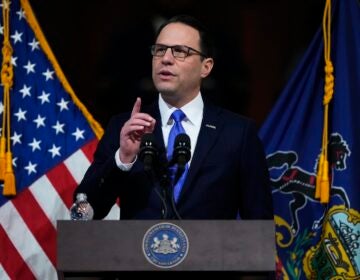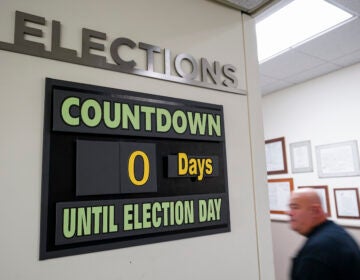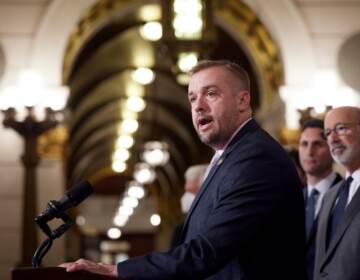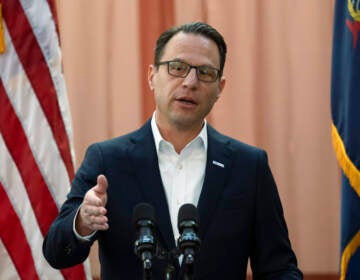Pennsylvania is flush with surplus cash, but it still faces a looming budget problem
Pennsylvania persistently spends more than it makes in revenue, but lawmakers have struggled for years to agree on lasting solutions.
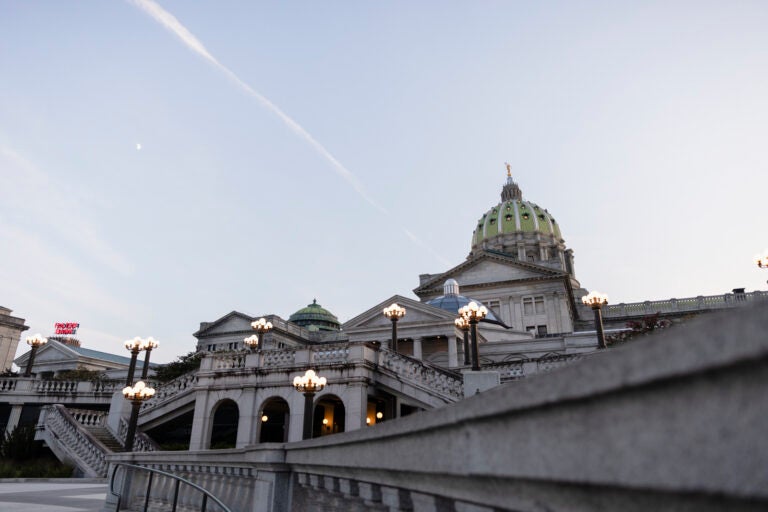
Pennsylvania State Capitol building in Harrisburg on July 26, 2023. (Amanda Berg for Spotlight PA)
This story originally appeared on Spotlight PA.
Gov. Josh Shapiro wants to spend $3.5 billion of Pennsylvania’s surplus to stabilize transit systems, fund a court-mandated K-12 education overhaul, and expand the state’s economic development programs as part of his second budget proposal.
The state can afford such an expense. It has built up roughly $14 billion in financial reserves over the past four years, thanks to stimulus dollars and strong tax returns.
But if Pennsylvania had to rely solely on the tax revenue the Shapiro administration projects to bring in over the next few years, it wouldn’t be able to cover the tab.
That’s because Pennsylvania has a structural deficit. The state’s annual costs, such as paying public servants and providing health care to people who can’t afford it, consistently exceed the state’s annual tax revenue.
No government can avoid tax revenues periodically dipping, analysts noted. But long-term budget challenges like Pennsylvania’s can hollow out public services and burden local governments with covering unmet costs.
“Even without new initiatives, you have rising costs,” said William Glasgall, senior director of public finance at Volcker Alliance, a good-government group. “And if the projection of revenues does not match that, you have a structural deficit.”
Unlike the federal government, Pennsylvania cannot go into debt to cover its annual operating expenses. The state constitution prohibits the commonwealth from taking on debt except in a few specific scenarios, such as for disaster relief.
That essentially leaves lawmakers with two choices: spend less or bring in more money.
Instead, Pennsylvania’s divided executive and legislative branches have employed a variety of techniques that experts say hide the real cost of government. That includes accounting gimmicks, delaying payments to state contractors, leaving job openings unfilled, or flat funding key programs to make the numbers work.
“If you’re serving a larger population with the same number of workers, or if you have costs that are going up and your budget stays flat, often that means that effectively public services have been reduced,” said Josh Goodman, a fiscal health researcher with the Pew Charitable Trusts.
When the state punts on funding increases for education and other services, those costs are passed to counties, school districts, and nonprofits that rely on state dollars, Glasgall said.
Pennsylvania’s failure to meaningfully deal with its structural deficit may also have serious consequences if it needs to borrow money. Glasgall said lenders would “catch on” and see the state as a bad fiscal bet, and increase the cost to borrow.
As lawmakers begin negotiating this year’s budget deal in earnest, few are talking about the tax hikes or spending cuts that would be necessary to permanently bring the commonwealth’s finances in order.
And while the state has extra money available now, those dollars could quickly disappear if Pennsylvania continues spending at its current rate.
Pennsylvania’s primary revenue sources are broad-based taxes on sales and income for individuals and businesses, but so far Shapiro hasn’t proposed increasing these. In fact, he’s argued that Pennsylvania should more quickly implement cuts to its corporate net income tax.
Shapiro has avoided talking about the structural deficit while pitching his spending ideas, instead emphasizing the size of the state’s surplus and the need to invest it in communities.
“Look, it is not a badge of honor, nor is it something to be politically proud of for some lawmakers out there to say, ‘I took more money from the good people of Pennsylvania than I needed and then bragged about how I just kept it in some bank account here in the Capitol,’” Shapiro said in his budget address.
Republicans in the state legislature have pushed back, saying that the state should cut spending rather than tap its savings. They also argue that sitting on money is fiscally prudent.
State Senate Appropriations Chair Scott Martin (R., Lancaster) noted that Pennsylvania earns interest on its surplus and that spending it down would decrease returns. He added that spending surplus funds would not be a sustainable solution to the state’s structural deficit.
“We’re going to be in big trouble if we think that we can spend this entire surplus,” Martin told Spotlight PA. “We would just create a much bigger hole.”
How did we get here?
The commonwealth’s surplus is split between its rainy day fund, which is essentially a long-term savings account that requires a two-thirds vote of the legislature to tap, and its general fund. The latter is effectively its main checking account and accrues most state tax revenue.
Experts have said that states should keep about 12% to 15% of their total annual costs in a rainy day fund; this year, the target would be about $7 billion in Pennsylvania. But just five years ago, it contained only $22 million — enough to run the state government for just a few hours.
The fund was depleted during the Great Recession under Democratic Gov. Ed Rendell. After federal stimulus dollars ran out, lawmakers struggled during Republican Gov. Tom Corbett’s four years in office and Democrat Tom Wolf’s first term to balance the budget.
Corbett, who had pledged not to raise taxes, largely tried to deal with the financial situation by supporting spending cuts.
The enacted cuts included a 10% reduction in funding for county human services, and, most significantly, a $1 billion reduction in funding for education. Corbett and his allies argued the latter was necessary because the Rendell administration had used stimulus money to prop up the budget. Regardless, the strategy made Corbett unpopular and he lost his reelection bid to Wolf.
New taxes or increases to existing ones have played a small role in solving recent budget woes. Wolf proposed increasing the state’s flat income tax rate and taxing natural gas drillers by the volume of gas extracted, but the then-GOP-controlled legislature didn’t bite.
Instead, Wolf and the legislature balanced the books and raised one-time revenue through a mix of temporary solutions, like issuing new casino licenses and borrowing against the state’s share of tobacco settlement revenue.
The state has also delayed payments or purposefully undercounted projected Medicaid expenses to appear to balance annual budgets.
In 2017, for instance, Republicans agreed to a budget that was underfunded by hundreds of millions of dollars, and gave Wolf the authority to fill the gap by drawing money from the state’s special funds for things like transportation.
Wolf, who opposed that approach, instead borrowed money from a venture capital company against the Pennsylvania Farm Show Complex in Harrisburg, leaving the state on the hook to pay back $191 million in interest for decades to come.
The commonwealth’s budgeting strategies between 2015 and 2019, which often amounted to moving money around or taking on debt, were sharply criticized in a 2021 report from the Volcker Alliance. The report highlighted the commonwealth’s reliance on what the group termed “budget maneuvers.”
“To avoid creating long-term structural deficits that burden future budgets, states should pay for expenditures with recurring revenues earned the same year,” the report said. “Budget maneuvers are states’ major tool for moving budgeted costs to the future or bringing expected revenues into the current year.”
These are actions taken consistently by “particularly challenged states,” the report said, and it ranked Pennsylvania as the single worst “maneuver” offender. The average grade for states in this category was a B; Pennsylvania received the sole D-minus in the nation.
The commonwealth’s use of debt during its tight budget years wasn’t just fiscally dicey — it may have been unlawful, although no one challenged it at the time.
Unlike the federal government, which typically runs deficits in its yearly spending, the Pennsylvania Constitution says that the commonwealth can only go into debt to “suppress insurrection,” “rehabilitate areas affected by man-made or natural disaster,” or pay for capital projects. All other uses of debt must be approved by voters through a referendum.
Pennsylvania’s financial situation changed for the better in 2019, as it began taking in higher-than-expected tax revenues. Then, the pandemic brought extra federal aid to the states, while direct federal cash payments to everyday people increased sales and income tax receipts. Combined, this filled Pennsylvania’s coffers.
While there have been budget fights since, they have centered on how to spend the extra dollars, and not how to make up missing money.
However, the state’s fundamental fiscal situation remains unchanged. Projections from both the Shapiro administration and the Independent Fiscal Office, a nonpartisan budgetary agency, show that the state’s revenues will not cover its expenses for the next five years.
What’s next?
Conservative lawmakers and policy wonks argue the path to a balanced budget chiefly involves slashing state spending, particularly low-income assistance programs.
The budget for Pennsylvania’s Department of Human Services, which handles the commonwealth’s social safety net, has increased by 70% in the past 10 years, which is faster than the growth of the state’s overall spending. In particular, this increase has been driven by rising health care costs, said Nathan Benefield, president of the conservative Commonwealth Foundation.
The state is required to foot part of the bill for low-income individuals’ health care, splitting payments with the federal government. However, states have some power to control who and what care is covered.
“We’re going to be at a deficit this year, but we should be looking at a way to close that in the next few years,” Benefield said.
In recent years, Republican lawmakers have spearheaded cutting small direct cash payments for the very poor, known as General Assistance, and have pushed to add work requirements to the state’s Medicaid program. The latter effort was repeatedly vetoed by Wolf.
For Democrats, fears of fiscal disaster ring hollow for a simple reason — the state has consistently found ways to balance its books without a significant tax increase. The last time Pennsylvania increased its income tax was in 2004; its last sales tax hike was in 1968.
“We’ve been hearing the sky is falling for, what, 20 years now?” state Sen. Vincent Hughes (D., Philadelphia), minority chair of the upper chamber’s Appropriations Committee, told Spotlight PA. “And the sky has not fallen.”
He called for the surplus to be spent on education and workforce development to spur future growth.
A few state House Democrats are floating increasing revenue to address the root cause of the imbalances. In particular, they propose changing the Pennsylvania Constitution to allow for the state to tax the rich at a higher rate than the poor.
Such a proposal was among the first bills that state Rep. Elizabeth Fiedler (D., Philadelphia) put her name on after she took office in 2018, and she’s still championing it to this day.
She’s recently noticed more interest in the issue — a state House subcommittee in the now-Democratic-controlled chamber held a hearing on the topic last month.
The state’s tax system, Fiedler told Spotlight PA, should “bring us a continuous and predictable source of revenue so that we can keep up things like the investment in education [and] the investment in mass transit.”
“I think those are really sound investments for all of us to make, and certainly for the richest Pennsylvanians,” she added.

Get daily updates from WHYY News!
WHYY is your source for fact-based, in-depth journalism and information. As a nonprofit organization, we rely on financial support from readers like you. Please give today.


